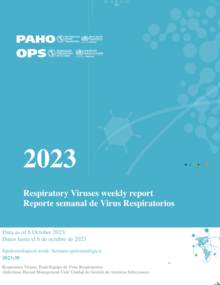North America: Influenza activity has remained at low levels. Over the past 4 epidemiological weeks (EWs), the predominant influenza viruses have been influenza A(H1N1)pdm09, with concurrent circulation of influenza B/Victoria. Respiratory syncytial virus (RSV) activity has also remained low. SARS-CoV-2 activity continues to rise at moderate levels. Cases of influenza-like illness (ILI) and severe acute respiratory infection (SARI) continue to increase, with the majority of cases testing positive for SARS-CoV-2. In Mexico, influenza circulation in the last 4 EWs remains at epidemic levels, and SARI activity is at moderate levels, with most cases associated with SARS-CoV-2 and to a lesser extent with influenza.
Caribbean: Influenza activity continues to show a declining trend over the past 4 EWs. During this period, the predominant influenza viruses have been B/Victoria, with lower circulation of influenza A, mainly A(H1N1)pdm09. RSV activity has remained low. SARS-CoV-2 activity has been at intermediate levels of circulation. ILI and SARI cases have shown a decreasing trend in the last 4 EWs. Barbados, Guyana, Jamaica, and Saint Lucia have reported high levels of SARS-CoV-2 circulation.
Central America: Influenza activity continues to decline over the past 4 EWs. During this period, the predominant influenza viruses have been influenza B/Victoria, with concurrent lower circulation of influenza A, mainly A(H1N1)pdm09. RSV activity has remained high over the last 4 EWs. SARS-CoV-2 activity is at low levels with a decreasing trend. The number of newly detected cases of ILI and SARI has remained low; however, the proportion of cases attributable to RSV has shown a peak over the last 4 EWs. In El Salvador, RSV activity remains high, coinciding with an increase in SARS-CoV-2 circulation, which also remains high, and to a lesser extent, influenza circulation. In Guatemala, over the last 4 EWs, RSV activity remains high, with the majority of ILI and SARI cases testing positive for RSV. In Honduras, after reaching high positivity rates for influenza, the last 4 EWs have seen a decline to levels below the epidemic threshold. SARS-CoV-2 activity, following a recent peak, has shown a decreasing trend in the last 3 EWs. SARI cases have increased over the last 4 EWs, with almost all positives related to influenza. In Nicaragua, influenza activity continues to decline at epidemic levels. In Panama, influenza activity currently remains at epidemic levels, and RSV activity continues to rise, reaching moderate levels.
Andean Region: Influenza activity remains stable at low circulation levels. Over the last 4 EWs, the predominant influenza viruses have been influenza B/Victoria, followed by influenza A, mainly A(H1N1)pdm09. RSV activity remains low but has shown a slight increase. SARS-CoV-2 remains at moderate levels with a slight increase, especially in Bolivia. SARI activity continues to decline, with most cases associated with influenza and, to a lesser extent, RSV and SARS-CoV-2. ILI activity has shown a decreasing trend, with the majority of cases associated with influenza.
Brazil and Southern Cone: Influenza activity remains at low circulation levels. Over the last 4 EWs, the predominant influenza viruses have been mainly influenza B/Victoria, with simultaneous circulation of influenza A(H1N1)pdm09. RSV activity remains low. SARS-CoV-2 activity has increased, reaching intermediate levels of circulation. Both SARI and ILI activities have remained low over the last 4 EWs. Argentina has seen an increase in SARS-CoV-2 activity, although ILI and SARI levels remain below the epidemic threshold. In Brazil, an increase in SARS-CoV-2 activity has been observed, although with low positivity rates. In Chile, a pronounced increase in SARS-CoV-2 activity has been detected, with intermediate levels of circulation and moderate ILI levels. In Paraguay, ILI activity has shown a slight increase associated with SARS-CoV-2, while SARI activity continues to decline. In Uruguay, SARI activity has continued to decline over the last 4 EWs, with most cases associated with RSV and, to a lesser extent, SARS-CoV-2.
|

